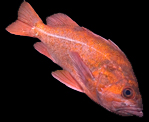
Wewak and Madang
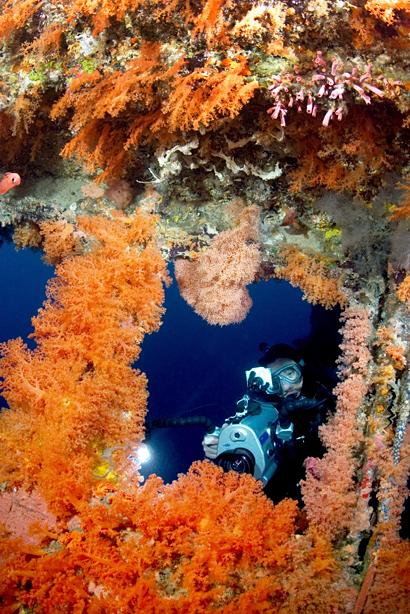
Clinton Bauder peers into the wheelhouse of the FS-172 Boston. Likely the
swift current is at least partly responsible for the beautiful soft corals
adorning this wreck. Perhaps this strong current, or the way it swirls through
the cavities in the ship also explains why the small fish in this image are
swimming upsidedown! While jumping in the water for a dive is often magical in
that one is instantly transported to an enticing and fantastic environment, the
experience of this dive seems to have been turned on its head. It is not the
start of the dive that sticks in my mind, but the end. At shallow depths, the
crystal blue water seen in this picture turned to a turbid white that concealed
even my own feet. On the surface, wind screamed and waves broke with fury on the
lava rocks not more than fifty feet away. Confusion seemed to abound and I
scrambled to doff equipment and climb into the inflatable, all while minding the
danger of the near by beach. In the midst of this, like some beam of sun in a
tempest, children from some local village, laughed and waved to me from the palm
trees behind the breakers. Despite my discomfort in my situation, I couldn't
suppress a return wave. During my entire time in New Guinea, local adults and
children alike trailed after divers, expressing deep fascination, perhaps even
awe. At no other time, however, was the barrier of the fishbowl in which we were
watched broken. Yet it seemed to have been broken by this simple wave.
"Wewak and Madang", Papua New Guinea
August 21, 2005
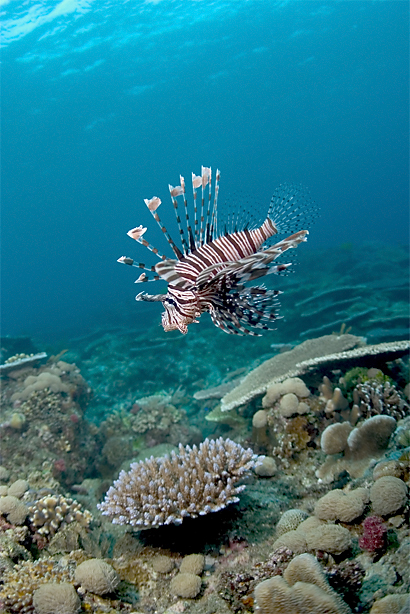
Lionfish (Pterois sp.) like this one are poor swimmers. For defense they
rely upon their large array of venomous spines rather than their speed. Once a
lionfish has been discovered, it's usually not difficult to get quite close to
it. However, obtaining a pretty photograph is a bit of a challenge since
lionfish usually stay quite close to some benthic structure and often turn their
tail (and thus the points of their spines) toward their observer. Patience and
careful body positioning may be required to get a shot that has a uniform
background that will nicely highlight the lionfish's complex silhouette.
"Wewak and Madang", Papua New Guinea
August 20, 2005
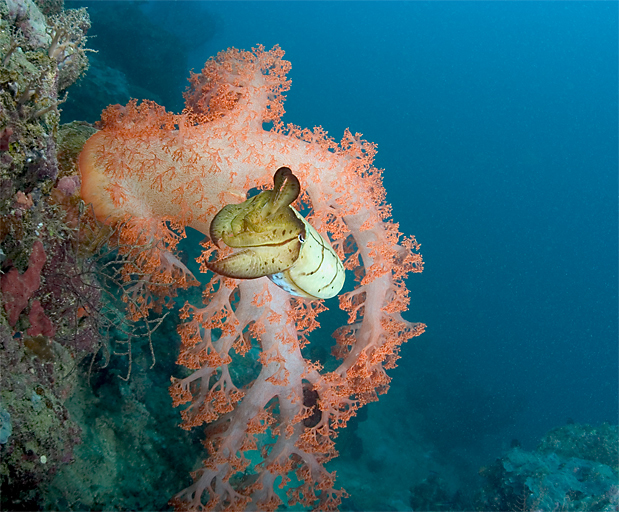
Broadclub cuttlefish (Sepia latimanus). Like octopuses and squid,
cuttlefish are cephalopods. Like their more commonly known cousins, cuttlefish
swim in the opposite direction that they're looking. Here one makes a methodic
retreat to the back side of a soft coral.
"Wewak and Madang", Papua New Guinea
August 22, 2005
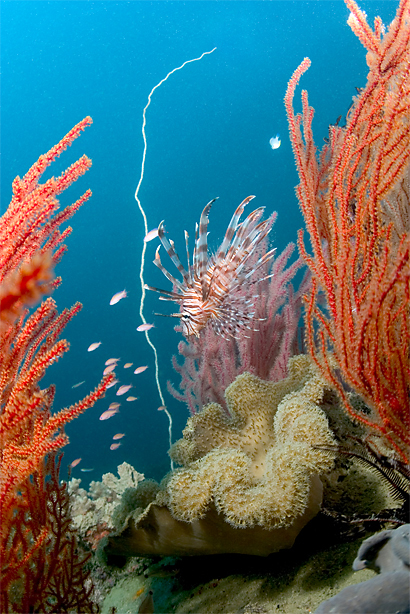
Lionfish, (Pterois sp.). Lionfish spines contain some really nasty venom.
The photographer had a pit in his stomach and fear in his heart as he took this
shot. It wasn't the fish pictured that was the cause for concern, but, rather,
its identical twin hovering disturbingly close to the photographer's bare cheek.
I suspect I would have let this shot go if Golden Dawn skipper Craig de
Wit had recited his account of being stung by a blue-spotted stingray before we
did this dive rather than after. It seems that pretty much everything underwater
in New Guinea is capable inflicting pain. It was weeks after I returned home to
San Francisco before my hands, swollen and raw from twelve days of incidental
contact with various stinging nasties, healed completely.
"Wewak and Madang", Papua New Guinea
August 21, 2005
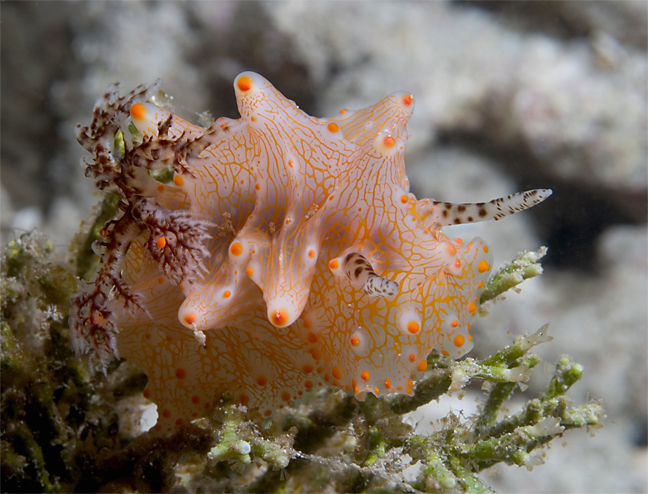
This is Halgerda batangas. If you're not a slug geek, this might not be a
very helpful description. Yes, this is a slug. More specifically, it's type of a
dorid nudibranch. The black tree-like structure at left is the animal's gill
plume. The two cylindrical projections at the right are sense organs called
rinophores.
"Wewak and Madang", Papua New Guinea
August 19, 2005
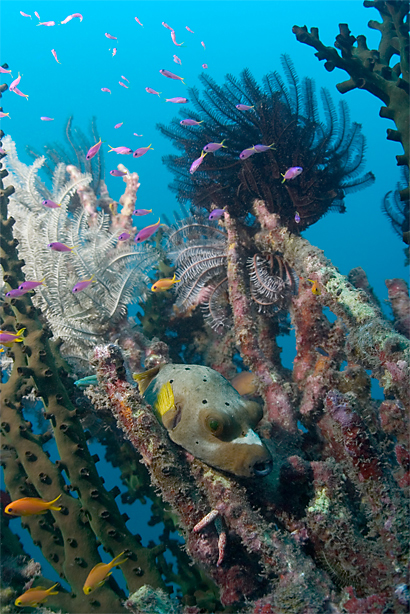
This blackspotted puffer (Arothron nigropunctatus) appears to have chosen
an odd perch. It may have been looking for a cleaning from some gobies that were
in the area. The feathery crinoids seen in the background are ubiquitous in New
Guinea and assume a vast range of colors. Crinoid arms can be quite sticky, and
clumsy divers may find their wetsuits decorated with one or more animals upon
returning to the boat.
"Wewak and Madang", Papua New Guinea
August 20, 2005

Clinton Bauder, David Chamberlin, and Craig de Wit under a billowing cloud of
muddy river water. Cold, opaque river water is slow to mix with the Bismark
sea's salt water. As such, on this dive, I couldn't see my hand when I pressed
it against my mask at a depth of 10 feet. Below a depth of about 40 feet,
however, the water was a beautiful blue.
"Wewak and Madang", Papua New Guinea
August 18, 2005

Clark's anemonefish (Amphiprion clarkii) and B-25 wreck
"Wewak and Madang", Papua New Guinea
August 21, 2005
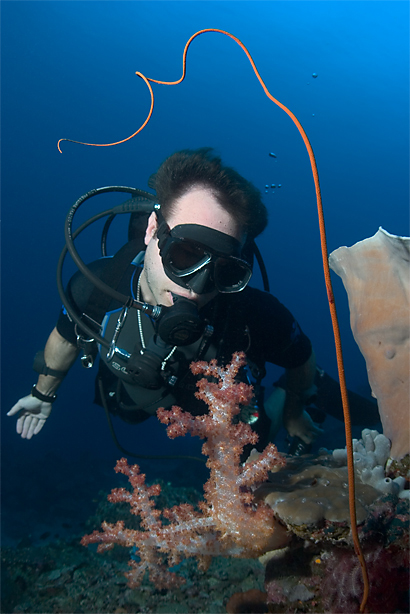
David Chamberlin looking at some invertebrates. If you look closely, you may be
able to see the goby resting the this sea whip. Not surprisingly, I didn't see
this little guy when the shot was taken.
"Wewak and Madang", Papua New Guinea
August 20, 2005
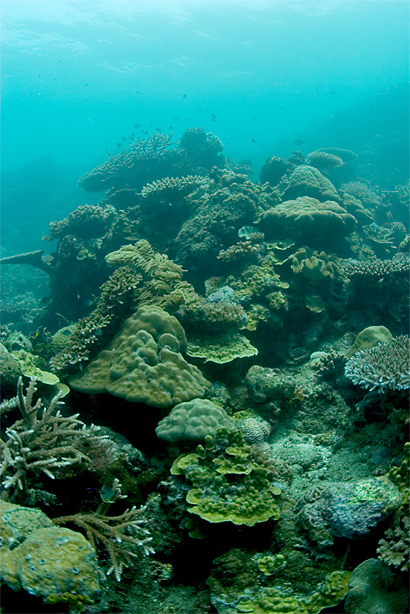
A collection of hard corals
"Wewak and Madang", Papua New Guinea
August 20, 2005
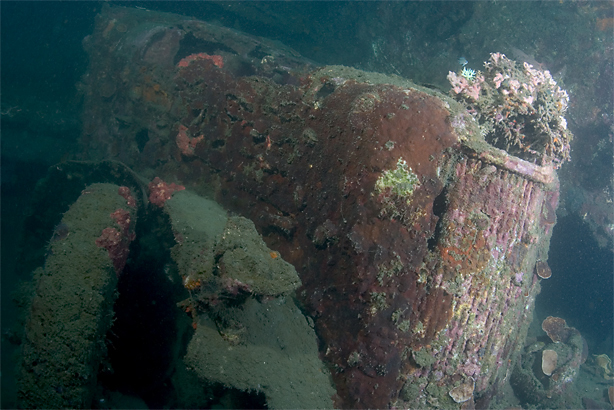
An automobile in the cargo hold of the so-called Sushi Maru.
"Wewak and Madang", Papua New Guinea
August 16, 2005














